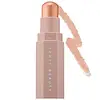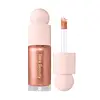What's inside
What's inside
 Key Ingredients
Key Ingredients

 Benefits
Benefits

 Concerns
Concerns

 Ingredients Side-by-side
Ingredients Side-by-side

Mica
Cosmetic ColorantEthylhexyl Isononanoate
EmollientOctyldodecanol
EmollientPolymethyl Methacrylate
Sucrose Acetate Isobutyrate
C20-40 Alcohols
EmulsifyingTribehenin
EmollientParaffin
PerfumingPolyethylene
AbrasiveVp/Eicosene Copolymer
Vp/Hexadecene Copolymer
Diisostearyl Malate
EmollientCera Microcristallina
Emulsion StabilisingCaprylyl Glycol
EmollientPhenoxyethanol
PreservativeTocopheryl Acetate
AntioxidantHexylene Glycol
EmulsifyingTocopherol
AntioxidantIsostearyl Alcohol
EmollientAscorbyl Palmitate
AntioxidantMalic Acid
BufferingCalcium Sodium Borosilicate
Synthetic Fluorphlogopite
Calcium Aluminum Borosilicate
Polyethylene Terephthalate
Acrylates Copolymer
Silica
AbrasiveTin Oxide
AbrasiveCI 77891
Cosmetic ColorantCI 77491
Cosmetic ColorantMica, Ethylhexyl Isononanoate, Octyldodecanol, Polymethyl Methacrylate, Sucrose Acetate Isobutyrate, C20-40 Alcohols, Tribehenin, Paraffin, Polyethylene, Vp/Eicosene Copolymer, Vp/Hexadecene Copolymer, Diisostearyl Malate, Cera Microcristallina, Caprylyl Glycol, Phenoxyethanol, Tocopheryl Acetate, Hexylene Glycol, Tocopherol, Isostearyl Alcohol, Ascorbyl Palmitate, Malic Acid, Calcium Sodium Borosilicate, Synthetic Fluorphlogopite, Calcium Aluminum Borosilicate, Polyethylene Terephthalate, Acrylates Copolymer, Silica, Tin Oxide, CI 77891, CI 77491
Isododecane
EmollientMica
Cosmetic ColorantHydrogenated Polyisobutene
EmollientHydrogenated Olive Oil Unsaponifiables
EmollientHydrogenated Styrene/Isoprene Copolymer
Octyldodecanol
EmollientDimethicone
EmollientGardenia Florida Fruit Extract
Skin ConditioningNelumbo Nucifera Flower Extract
Skin ConditioningNymphaea Odorata Root Extract
RefreshingPolyhydroxystearic Acid
EmulsifyingCaprylic/Capric Triglyceride
MaskingIsostearic Acid
CleansingHelianthus Annuus Seed Oil
EmollientTin Oxide
AbrasiveLecithin
EmollientPolyglyceryl-3 Polyricinoleate
EmulsifyingPentaerythrityl Tetra-Di-T-Butyl Hydroxyhydrocinnamate
AntioxidantCI 77891
Cosmetic ColorantIron Oxides
Isododecane, Mica, Hydrogenated Polyisobutene, Hydrogenated Olive Oil Unsaponifiables, Hydrogenated Styrene/Isoprene Copolymer, Octyldodecanol, Dimethicone, Gardenia Florida Fruit Extract, Nelumbo Nucifera Flower Extract, Nymphaea Odorata Root Extract, Polyhydroxystearic Acid, Caprylic/Capric Triglyceride, Isostearic Acid, Helianthus Annuus Seed Oil, Tin Oxide, Lecithin, Polyglyceryl-3 Polyricinoleate, Pentaerythrityl Tetra-Di-T-Butyl Hydroxyhydrocinnamate, CI 77891, Iron Oxides
 Reviews
Reviews

Ingredients Explained
These ingredients are found in both products.
Ingredients higher up in an ingredient list are typically present in a larger amount.
Ci 77891 is a white pigment from Titanium dioxide. It is naturally found in minerals such as rutile and ilmenite.
It's main function is to add a white color to cosmetics. It can also be mixed with other colors to create different shades.
Ci 77891 is commonly found in sunscreens due to its ability to block UV rays.
Learn more about CI 77891Mica is a naturally occurring mineral used to add shimmer and color in cosmetics. It can also help improve the texture of a product or give it an opaque, white/silver color.
Serecite is the name for very fine but ragged grains of mica.
This ingredient is often coated with metal oxides like titanium dioxide. Trace amounts of heavy metals may be found in mica, but these metals are not harmful in our personal products.
Mica has been used since prehistoric times throughout the world. Ancient Egyptian, Indian, Greek, Roman, Aztec, and Chinese civilizations have used mica.
Learn more about MicaOctyldodecanol is a fatty alcohol. It is primarily used to enhance the texture of products.
As an emulsifier, Octyldodecanol helps prevent the oils and waters from separating. It also prevents ingredients from creating foam when shaken.
Octyldodecanol is created by reducing fatty acid to an alcohol.
Due to its high molecular weight, it does not get absorbed into the skin.
Learn more about OctyldodecanolTin Oxide is an inorganic oxide used to add opacity and volume to a product. In nature, it is already found in mineral form. The main ore of tin is an opaque and shiny mineral called casseterite.
Tin Oxide helps remove translucency in a product, or make it more opaque. Besides adding opacity, tin oxide is used for bulking to add volume.